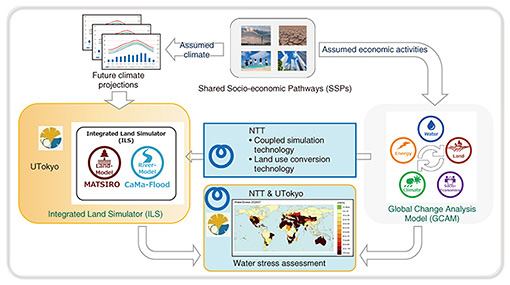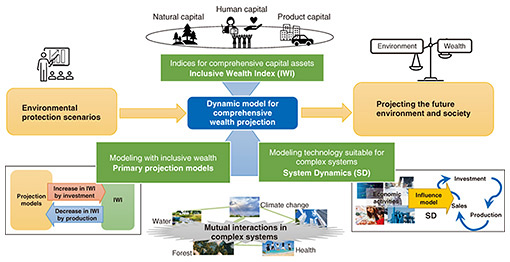 |
|||||||||||||||||||
|
|
|||||||||||||||||||
|
Feature Articles: Efforts in the Environmental and Energy Sector to Create a Sustainable and Resilient Society Vol. 22, No. 3, pp. 70–74, Mar. 2024. https://doi.org/10.53829/ntr202403fa8 Forecasting Technologies for Environmental and Socioeconomic Cycles for Attaining Inclusive SustainabilityAbstractThe Environmental and Socioeconomic Nexus Forecasting Technology Group has been in the process of developing a computer-based circulation system consisting of several models (e.g. natural environment, economic, and social). We aim to forecast changes in global-scale inclusive cycles for inclusive sustainability, in which the environment, economy, and society are interrelated and more stable. In this article, we describe our developments for forecasting environmental impact considering the interplay between the environment and economy and introduce a new index of affluence in the beyond GDP (gross domestic product) era. Keywords: climate and economic society, coupled simulation, inclusive wealth 1. Toward inclusive sustainabilityThe Environmental and Socioeconomic Nexus Forecasting Technology Group has been researching inclusive sustainability, which it defines as the sustainability made possible by the inclusive harmony between the autonomy of the Earth’s environment and the autonomy of economic and social systems that are part of that environment [1]. The Earth’s environment has autonomy, and problematic environmental changes are a result of the influence of human economic and social activities on this autonomy. This complex chain-reaction system can be viewed as an inclusive cyclical system that includes the environment, economy, and society on a global scale. However, it is difficult to understand all of these interactions through observation and measurement in the real world. It is also difficult to evaluate their impact on the environment, economic activities, and social activities due to implementation costs, time delays in the occurrence of impact, and irreversibility of mutual influence. The goal of our group is to contribute to achieving inclusive sustainability by reproducing the environment model, economic model, and social model as a cyclical system on a computer, and making it possible to calculate changes in inclusive cycles on a global scale [2]. By being able to forecast changes in inclusive cycles using a computer, we hope to contribute to the global discussion on what social systems should be and the transformations they need to undergo to get there. Toward this end, we have been developing a proof of concept of the cyclical system to realistically evaluate the relationship between the water cycle and food production under the effects of climate change. We introduce our research on forecasting the global environmental impact considering the interplay between the environment and the economy with regards to the global water cycle, as well as a new index of affluence in the beyond gross domestic product (GDP) era using a new market-evaluation model that emphasizes human social activities. 2. Forecasting global environmental impact considering the interplay between the environment and economy2.1 Coupled simulation technology for inclusive sustainabilityTo reproduce the complex systems of the environment, economy, and society on a computer more precisely, we combine simulators developed by specialists in each of these fields. Toward this end, it is necessary to exchange data following the causal relationship between variables in multiple simulators, and a method is needed to control execution while exchanging data at the appropriate timing by managing the internal time of each simulator in a unified manner. Such coupling technology is called coupled simulation. We developed a coupled simulation technology [3] that requires minimal modification to existing simulators and can be applied to various use cases. 2.2 Global-scale simulation considering the interaction between environmental and economic activities with a focus on the water cycleWe conducted an experiment to determine if inclusive sustainability could be investigated in more detail using the coupled simulation technology we developed, observe the difference with and without this technology, and verify its effectiveness. In this experiment, we focused on water, which is strongly related to both environmental and economic activities, and constructed a global-scale simulation that takes into account the interaction between environmental and economic activities, focusing on the global water cycle [4]. To reproduce the global hydrological cycle, we use the Integrated Land Simulator (ILS) developed by Prof. Kei Yoshimura’s research team at the Institute of Industrial Science of the University of Tokyo [5], which reproduces the surface-water-cycle process, and the Global Change Analysis Model (GCAM) [6], an integrated assessment model for economic activities developed by the Joint Global Change Research Institute (JGCRI). We hypothesized that changes in land-use patterns due to economic activity would affect the hydrologic cycle, which would then affect economic activity. To verify this, the ILS and GCAM were coupled using the coupled simulation technology to create a process that takes into account the annual land-use patterns due to changes in economic activity. The amount of water runoff calculated using the ILS and the amount of water consumption calculated using the GCAM were then compared. Through this comparison and observation of water-related changes in the environmental load (water stress*1) caused by changes in economic activities over time, we showed that large environmental loads can occur at times and places that could not have been predicted with conventional methods (Fig. 1).
We used one of the five Shared Socioeconomic Pathways (SSPs)*2 (SSP126) and implemented a system in which two different simulators are linked to each other to conduct global-scale calculations. For the Niger River basin, for example, where many areas are projected to change from grassland to cultivated land between 2020 and 2044, it was found that water stress tends to increase due to climate change. Increased water stress is somewhat mitigated as land is converted to cropland. The results of this experiment indicate that the water stress of the Niger River basin tends to increase with climate change [7] and that linking different simulators is effective for calculating large-scale environmental changes. 2.3 Future developmentsThere are two major challenges in reproducing the interactive effects of the environment and economic activities while considering various policies. First, simulating the environment requires excessive computations, so the amount of calculations needs to be reduced (lightened) and the process should be coupled with other simulations. Second, current scientific calculations are based on scenarios of socioeconomic factors that assume changes in population, economic growth, rate of technological development, etc., making simulations based on other various socioeconomic scenarios difficult. Therefore, we aim to improve the accuracy of global-scale simulations and increase the number of trials while reducing the amount of calculations for efficiency. Furthermore, the combination of new models will enable a more detailed analysis of the challenges of limiting temperature increase to within 1.5°C, as discussed by the Intergovernmental Panel on Climate Change (IPCC), contributing to society’s continued sustainable economic development on a scientific basis.
3. A new index of affluence in the beyond GDP era3.1 BackgroundDue to the growing importance of environmental measures for reducing carbon emissions, carbon-emission trading measures such as carbon credits are being promoted at the national, regional, and local levels. For such measures to be continuously operated and effective, they need to contribute to achieving environmental goals and enrich society as a whole while balancing environmental measures, the economy, and our daily lives. Our challenge is to develop technologies to dynamically predict how the wealth of the world will change as a result of environmental measures in the long term and evaluate the inclusive sustainability of the environment, society, and economy. 3.2 Challenges with dynamic long-term forecasting and assessment of the world’s overall wealthIt is necessary to take a holistic view of the world’s overall wealth, environment, and social trends to replicate general behavior that will take place in the environment and society of the future. The wealth we are trying to measure is not limited to economic wealth, such as material wealth, but also the wealth of the natural environment and resources as well as health and education. Indicators are needed to evaluate the overall wealth of the environment, people, and goods. The environment and society interact and behave as a complex system. Therefore, social changes caused by one of the environmental measures may result in a chain of unintended consequences, such as improved forest conservation but accelerated consumption of other resources, or slower-than-expected economic growth. When considering environmental measures, it is more important to determine the overall movement of a measure’s various implementations and predict the general outlook than to reproduce and predict the precise movements of the environment and society over time. 3.3 Research approachWe focus on the inclusive wealth index (IWI) and system dynamics (SD) to address these challenges. The IWI is for conducting a comprehensive wealth assessment. GDP is the most widely known indicator of economic wealth. However, there is a growing awareness of the importance of measuring the overall wealth of the world, including the wealth of the environment and people. Since it is difficult to measure wealth in terms of GDP, we have entered what is known as the Beyond GDP era. Therefore, we focus on the IWI, which is attracting attention internationally as an indicator for analyzing the comprehensive wealth of a country or region and measuring and evaluating natural wealth (environment, resources, etc.), people (education, health, etc.), and artifacts (products, facilities, etc.) in the region. Whereas GDP cannot assess resource depletion or health hazards, the IWI directly assesses the value of nature and people, thus can be used to assess such impact. Predictive models for the environment and society are constructed using SD, a systems-thinking and modeling method for complex systems. SD generates numerical models by representing causal relationships among known elements in a graphical form. It is suited for simple description and trend forecasting of complex systems, making it suitable for predicting environmental policies. Combining the IWI and SD, we examined the common structures between environmental social cycles and affluence and modeled the impact of environmental measures on affluence (Fig. 2).
3.4 Future developmentsWe are developing an IWI-based environment and society forecasting model to predict environmental goals and affluence. We are currently in the process of validating the dynamic predictions made in this research by creating a simulation model on emissions trading in the carbon-credit market and evaluating its contribution to improving the wealth of society as a whole. References
|
|||||||||||||||||||













